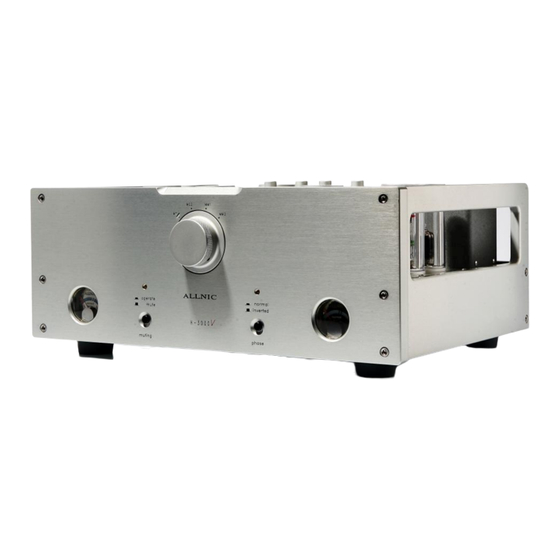ALLNIC AUDIO H-3000V Manuel du propriétaire - Page 4
Parcourez en ligne ou téléchargez le pdf Manuel du propriétaire pour {nom_de_la_catégorie} ALLNIC AUDIO H-3000V. ALLNIC AUDIO H-3000V 15 pages. Phono stage
Également pour ALLNIC AUDIO H-3000V : Manuel du propriétaire (15 pages), Manuel du propriétaire (15 pages)

INTRODUCING THE H-3000V PHONO STAGE
The H-3000V is a special version of Allnic Audio's top of
the line phono stage model. Like all Allnic Audio
products, it uses Permalloy (iron and nickel alloy) for its
transformer cores. Allnic is grateful to Mr. G.W. Elmen
of Western Electric for inventing Permalloy for
transformer core use, and in so doing, providing an
enormous service to recorded music listeners
everywhere.
The H-3000V has the following features:
LATEST UPGRADED OUTPUT TRANSFORMERS:
The H-3000V is equipped with the latest
production, larger output transformers (available
on all H-3000s produced after September 1, 2010
and otherwise available as an upgrade for the H-
3000 from Hammertone Audio).
LCR TYPE PRE-RIAA AND RIAA EQUALIZATION:
RIAA equalization is a specification for the correct
playback of vinyl records, established by the
Recording Industry Association of America. The
purpose of the equalization is to permit longer
playback times and improve sound quality. Before
the establishment of the RIAA equalization
standard, different production companies utilized
different equalization curves.
Vinyl record production equalization is a form of
establishing a flat frequency response for the
playback of recorded music. The necessity for this
equalization process arises from mechanical
difficulties inherent in record production. In order
to prevent the cutting needle from over-cutting into
the next record groove in the bass, as a record is
cut, some bass frequencies are attenuated. In the
treble region, in order for high frequency sounds
not to be masked by the noise inherent in moving a
stylus over and through a modulated vinyl surface,
some treble frequencies are boosted. With the
application of the correct filtering techniques on
playback, the result is a flat frequency response
with better signal to noise ratios.
The H-3000V is equipped with newly developed
Allnic "Multi-Curve" LCR units (one for each channel)
which have four (4) Turn-overs (frequency options)
and four (4) Roll-offs (gain reductions in dB). These
new units provide for the reproduction of various
recording curves (both for bass attenuation and
treble boost) used by different companies prior to the
establishment of the RIAA standard. There are 4 Turn-
over options, at: 250Hz, 400Hz, 500Hz RIAA and 700Hz.
There are 4 Roll-off options (at 10KHz): -5dB, -11dB, -
13.7dB RIAA and -16dB (See Figure 7).
There are four de-emphasis methods for equalization to
that can be applied at playback:
A.
Active filters (Negative feedback types):
Different quantities of negative feedback are applied,
with deeper feedback to the high frequencies and
shallower to the low frequencies. The benefits of this
method are improved signal to noise ratios, low cost and
consistent operation. Some of the shortfalls are looser
bass reproduction and, possibly, a pinched and
compressed high frequency playback due to excess
feedback ratios.
B.
Passive filters (CR type):
The frequencies are filtered to fit the RIAA specification by
varying the amount of attenuation at different frequencies
through a complex capacitor-resistor network. This
technique results in no voltage overload, purer
reproduction (because there is no feedback), and more
accurate RIAA compensation. However, there are problems
because the system provides no gain, and insertion loss and
impedance matching issues arise.
C.
Hybrid filters (use of both CR and negative feedback
types):
In this method, both types of filters applied separately; an
active filter is applied to the low frequencies and a passive
filter to the high frequencies. Unfortunately, both the
advantages and disadvantages of each of these two types
4
